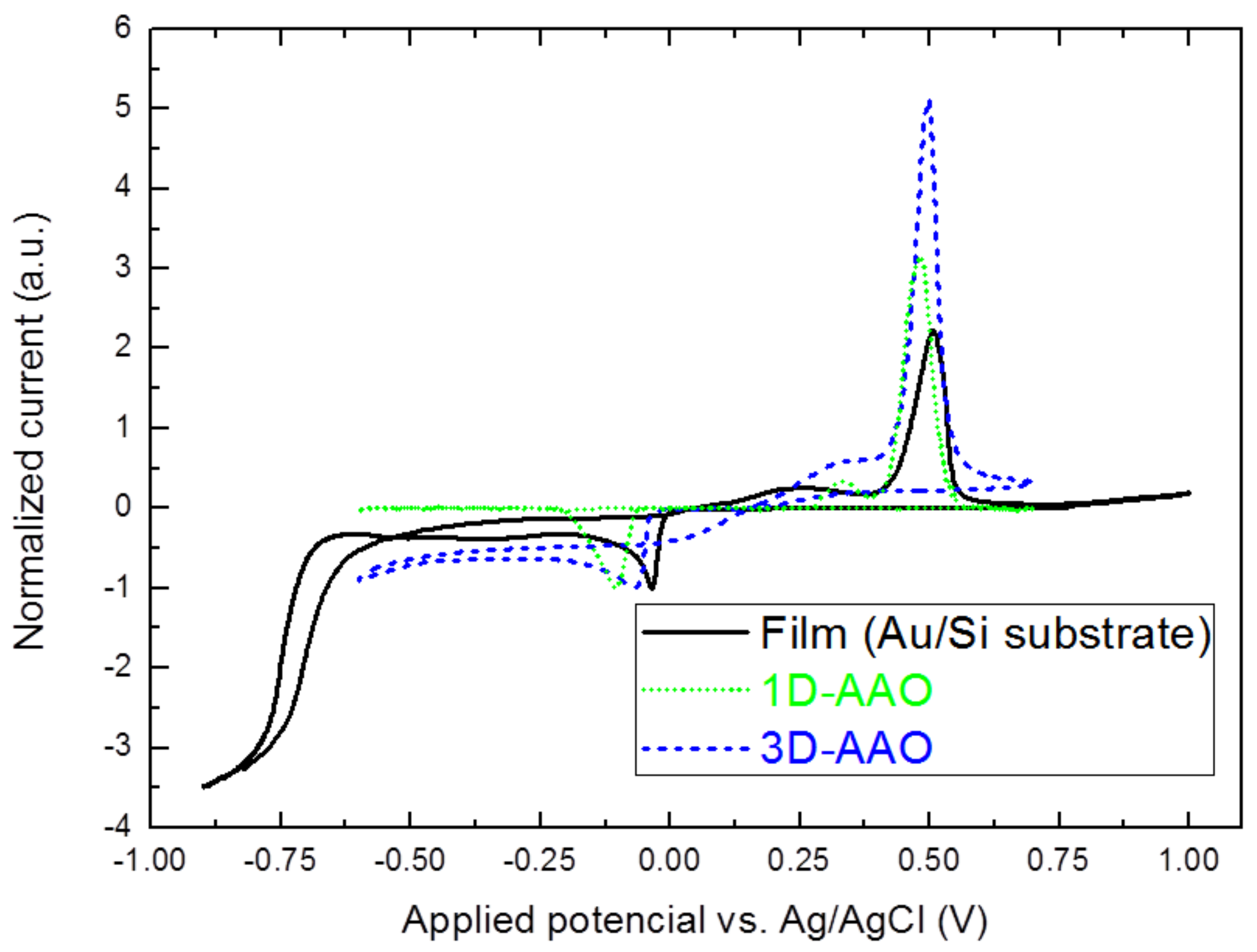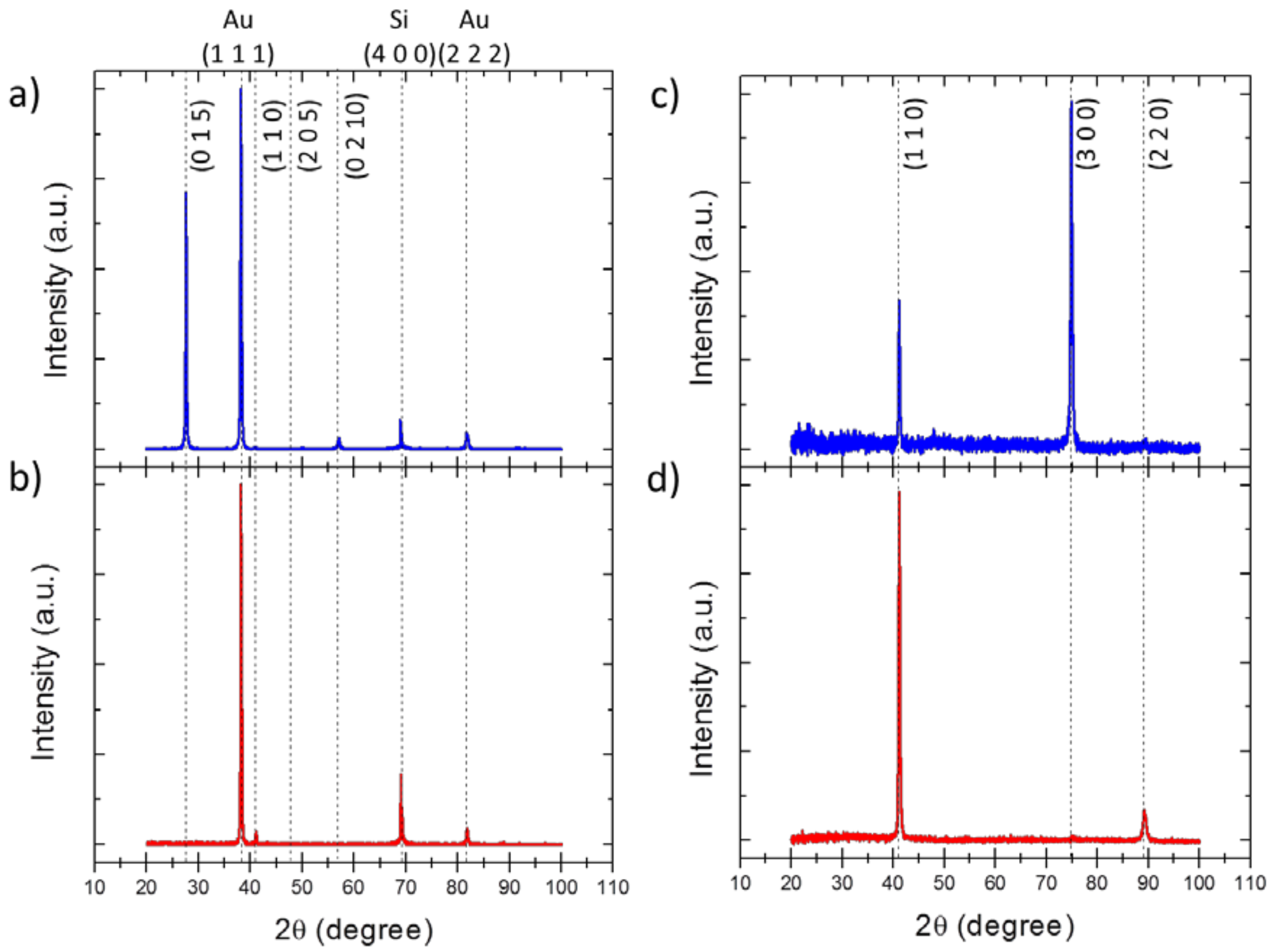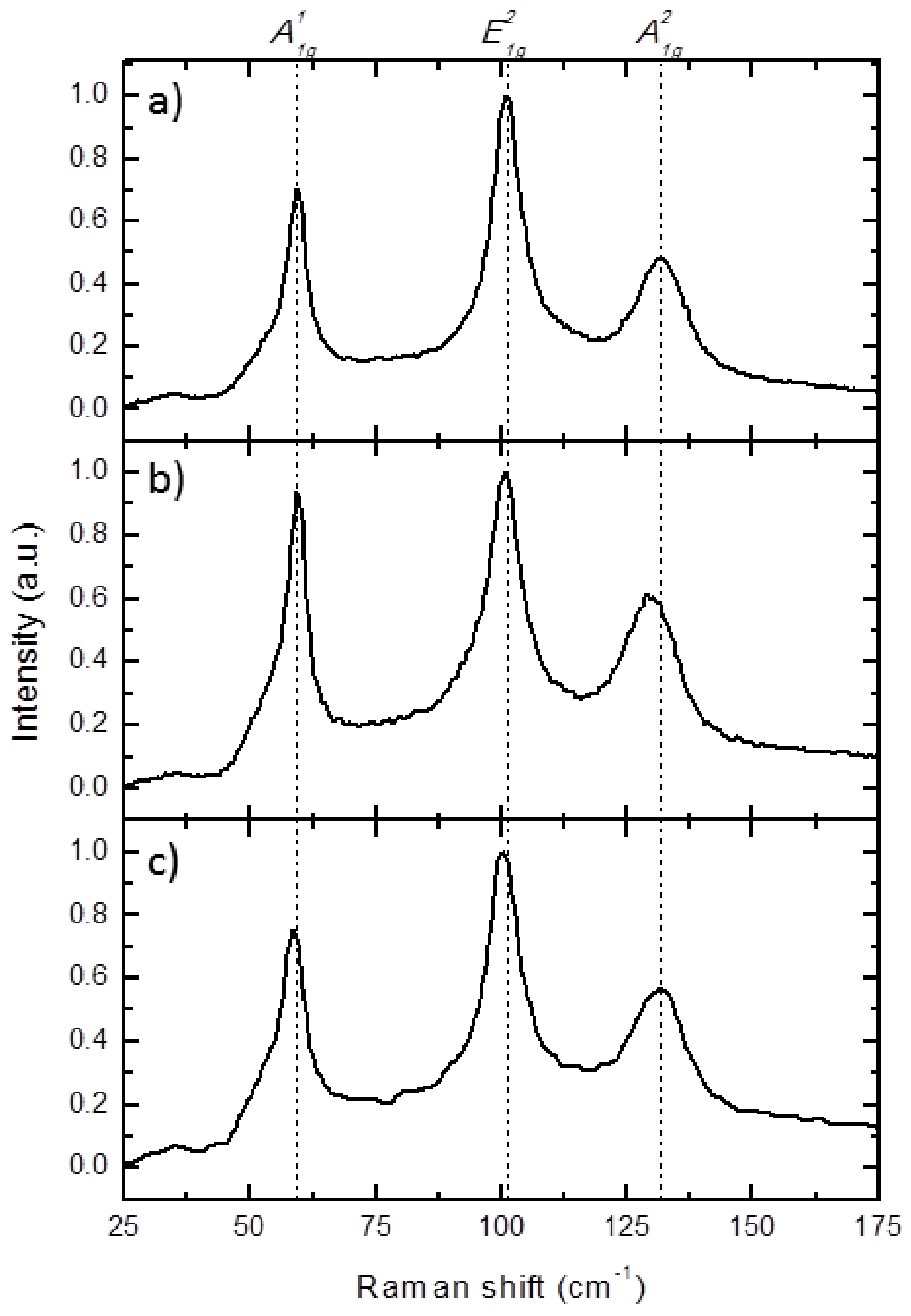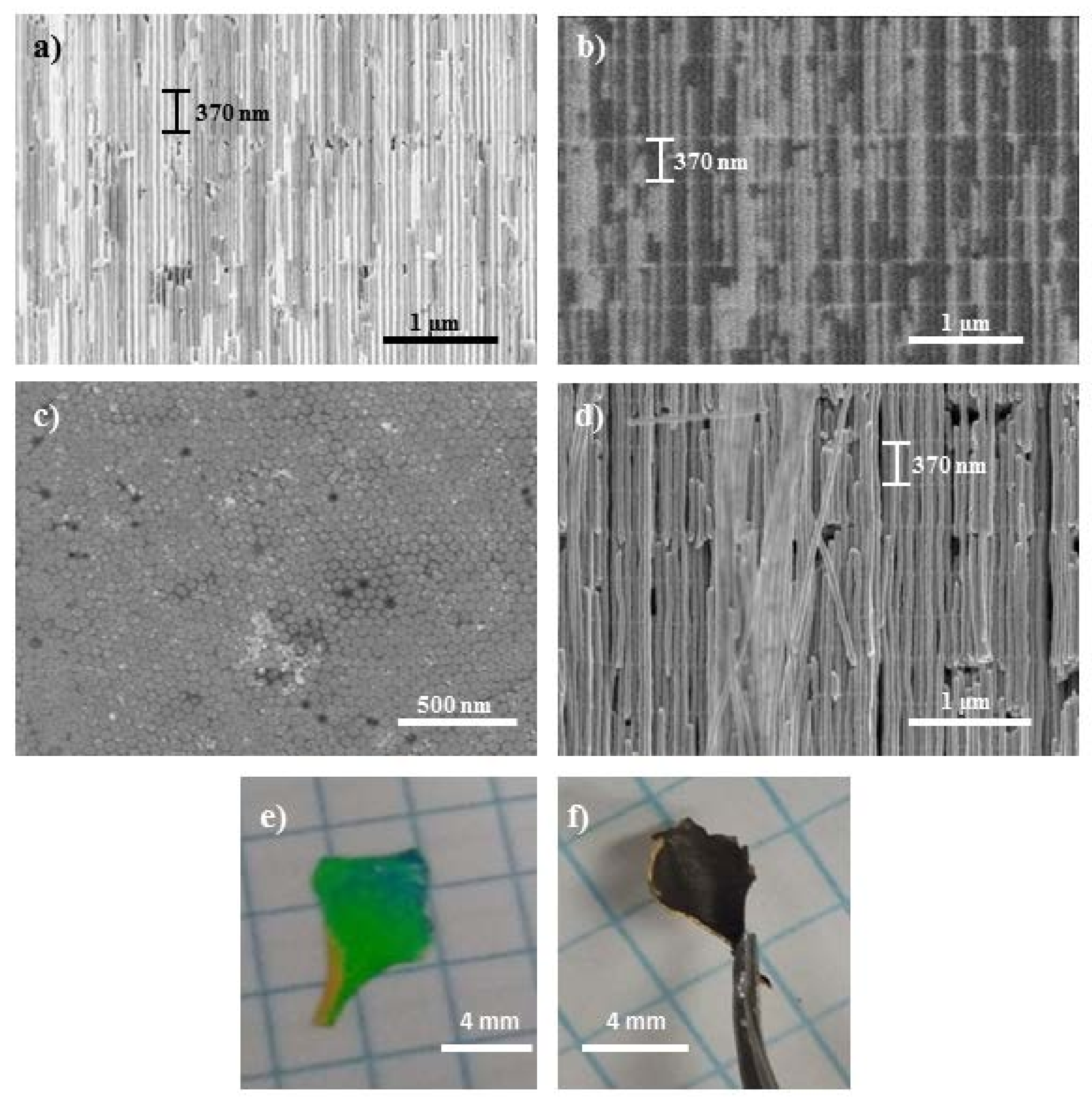1. Introduction
Thermoelectric devices have raised the interest of the scientific community due to their capability to convert thermal energy directly into electrical energy and vice versa, as in power generators and coolers. The necessity of developing alternative energy sources other than those based on fossils fuels has brought thermoelectric materials into the spotlight. However, the applications of thermoelectric based devices are still limited as consequence of their low efficiency. The performance of a thermoelectric device is proportional to its figure of merit,
ZT, which is a dimensionless quantity defined as
, where
T,
S,
σ, and
κ are the absolute temperature, Seebeck coefficient, electrical conductivity, and thermal conductivity, respectively. The ideal thermoelectric material should have a high Seebeck coefficient, high electrical conductivity, and low thermal conductivity; these requirements are not easily met, though [
1].
A bismuth telluride semiconductor is one of the most commonly used materials for thermoelectric applications near room temperature. Further enhancement of its thermoelectric performance can be achieved by nanostructuration, more specifically by reducing its dimensionality, and so increasing the surface to volume ratio. One way of doing that is by fabricating nanowires. There has been reported a reduction of the thermal conductivity,
κ, of electrodeposited Bi
2Te
3 nanowires when decreasing their diameter from 200 to 20 nm [
2], as a consequence of the increase of the acoustic phonon scattering at the interfaces due to a higher surface to volume ratio.
However, the implementation of these nanostructures into actual devices is not straightforward. On the one hand, these nanowires are electrochemically grown inside a template, being Anodic Aluminum Oxide (AAO) [
3,
4] membranes the most used. Nevertheless, AAOs can diminish the thermoelectric performance of the whole composite, given that their thermal conductivity can be even higher than that of the nanowires embedded inside. On the other hand, if one thinks of dissolving the AAO matrix, the resulting nanowires would collapse, given that they have no mechanical support to hold them. Another issue to take into account is the difficulty to measure the transport properties at the nanoscale, in order to characterize the produced nanowires [
5,
6].
Nowadays there is much research devoted to different ways of nano-structuring, not only in the way of nanowires, but in order to attain different morphologies at the nanoscale for a variety of applications, such as the recent development of high performance Li/S batteries encapsulated in graphene nanosheets [
7], nanofiber membranes used for desalinization of seawater [
8], nanotubes used as functionalized nanocavities for drug delivery [
9], or nanospheres to study the morphology of porous structures and enhance mass transport [
10]. In this line of creating new structures at the nanoscale, we have recently developed novel AAO templates that we call three-dimensional AAO templates (3D–AAO). The fabrication involves a two-step anodization process: a first 24 h anodization at constant potential in sulfuric acid and a second anodization during which a series of different voltages, corresponding to mild and hard anodization, are applied, as reported in a previous work [
11]. The final 3D–AAO structures consist of longitudinal pores with a highly ordered hexagonal arrangement that is interconnected to its nearest six pore neighbors by transversal nanochannels. It is worth noting that these 3D–AAO structures can also be made in non-flat surfaces such as wires [
12].
In this paper, we report an in-depth characterization and optimization of the growth of self-standing 3D Bi2Te3 nanowire networks by pulsed electrodeposition using these 3D–AAO membranes as templates. And, we will show a comparison of these 3D Bi2Te3 nanowire networks with the results obtained with the fabrication of 1D nanowire arrays and films. The aim of this work is to study the dependence of the electrodeposition parameters (such as the applied voltage pulses, applied current density, time on and time off pulses, temperature, etc.) with respect to morphology, crystalline orientation, and stoichiometry of the 3D Bi2Te3 nanowire network structure. The final goals are determining the optimum fabrication conditions and seeing the differences when compared with normal 1D nanowire arrays or films. It is worth mentioning that these 3D Bi2Te3 nanowire networks are self-standing, mechanically stable, and easy to manipulate with a pair of tweezers once the 3D–AAO membrane is selectively removed. So, they could be used in the fabrication of a thermoelectric device based on Bi2Te3 nanowire arrays in the future.
2. Materials and Methods
The 3D–AAO template was fabricated by a two-step anodization process in 0.3 M sulfuric acid, with the second step consisting of alternating between mild and hard anodization pulses, as previously described in [
11]. After the anodization process, the remaining aluminum substrate was eliminated using HCl/CuCl
2 solution. A subsequent etching treatment was carried out by 10% H
3PO
4 in order to remove the barrier layer, followed by 5% H
3PO
4 etching to open up the transversal channels. As a result, a 3D–AAO template consisting of highly ordered nanopores of around 40 nm in diameter, connected with transversal channels of about 20–30 nm in diameter, is obtained. The distance between the transversal channels can be completely tailored by modifying the pulses of the second anodization step.
The electrodeposition process was performed in a conventional three-electrode cell configuration with a Ag/AgCl saturated electrode as the reference, a platinum mesh as counter electrode and the 3D–AAO template with a 5 nm Cr and 150 nm Au layer evaporated in one of its surfaces and then attached to a copper holder with silver paste, acting as working electrode. Also, conventional alumina templates(1D-AAO) of 40 nm diameter longitudinal pores, evaporated with 5 nm Cr and 150 nm Au and attached to a copper holder, were used as a working electrode in order to carry out a comparative study between the growth of 3D nanowire networks and conventional 1D nanowire arrays. The copper holder was then covered with nail polish in order to isolate it electrically from the solution. In the case of the films, a third working electrode, consisting of a silicon substrate covered with 5 nm Cr and 150 nm Au was used for the comparison. The electrolyte solution used was the same in all the cases and consists of 0.90 × 10−2 M Bi3+, 1 × 10−2 M HTeO2+, and 1 M HNO3. The solution was prepared from Aldrich(R) Bismuth pieces (99.999%), Aldrich(R) Tellurium powder (99.997%), and Panreac 65% nitric acid. Nitric acid is used because H+ acts as the supporting electrolyte of the solution and NO3− as counterion. The preparation of the solution required several steps: Initially, Bi3+ was dissolved in nitric acid. Then the Tellurium powder and de-ionized water are added to the solution, in that order.
Bi
2Te
3 was grown by pulsed electrodeposition, switching between a potenciostatic and galvanostatic mode. The applied pulses were alternated between a certain constant potential, during a time on of 1 s and zero current density, at different time off, as reported in previous works [
13,
14]. The applied potential versus Ag/AgCl in the potentiostatic part of the pulses was determined by a cyclic voltammetric (CV) curve performed prior to each deposition. A bi-potentiostat (Autolab PGSTAT 302) was used with the customized software Nova 1.10 to obtain the cyclic voltammograms and to control the potenciostatic/galvanostatic pulses. Once the deposit was performed, the 3D–AAO matrix or the 1D-AAO matrix (where 1D-AAO stands for conventional anodic alumina with similar diameter pore than the 3D but without transversal interconnecting channels) was detached from the copper holder by immersion in acetone, obtaining a 3D network of Bi
2Te
3 nanowires inside the 3D–AAO template or a Bi
2Te
3 1D nanowire array, respectively. In the case of free-standing 3D Bi
2Te
3 nanowire networks, the 3D–AAO matrix was then dissolved in 7 wt % H
3PO
4 and 1.8 wt % H
2CrO
4 for 24 h.
The chemical composition of the different samples were studied by energy dispersive X-ray spectrometry (EDX, Hitachi S-3000 N), where we assume a 5% error in the atomic % value. Raman spectroscopy was used to corroborate EDX results (Jobin-Yvon LabRam HR using a Nb: YAG Laser, λ = 532 nm). X-ray diffractometry (XRD, Philips X’Pert PANalytical, with Cu Kα radiation, λ = 0.15418 nm) was employed to assess the preferred crystalline orientation of the formed Bi2Te3 structures. Structural characterization of both 3D Bi2Te3 nanowire network embedded inside the 3D–AAO membrane and free-standing wires was carried out by a high-resolution scanning electron microscope (HRSEM, FEI Verios 460) in order to verify that the connecting nanotubes were also filled and that the 3D–AAO structure was effectively replicated. HRSEM cross view measurements were carried out at an accelerating voltage of 2 KV and at a current of 50 pA, while top view images were taken at a lower current of 13 pA, in order to obtain a more detailed image of the surface of the polished sample. The magnification of the images was varied over a range between 15,000–35,000 × and the working distance (WD) used ranged from 3 to 4 mm.
3. Results
Firstly, a cyclic voltammetric study was performed to monitor the changes over the reduction peak of Bi
3+/HTeO
2+ species when growing films, 1D nanowires, and 3D nanowire networks. Cyclic voltammograms were carried out in the above mentioned electrolyte solution, at 0 °C, with a scan rate of 10 mV·s
−1 over a potential range between −1.0 to 1.0 V applied potential vs. Ag/AgCl in the case of gold over silicon substrate, and −0.6 to 0.7 V applied potential vs. Ag/AgCl when 1D-AAO and 3D–AAO membranes were used as templates (as shown in
Figure 1). The assignment of the reduction peaks of Bi
3+/HTeO
2+ species in solution has been thoroughly investigated by Martin-Gonzalez et al. [
15]. If we compare the cyclic voltammetry (CV) obtained with the one obtained when a gold layer over a silicon substrate is used as working electrode (which shows a reduction peak around −35 mV applied potential vs. Ag/AgCl), and with that recorded when a 1D-AAO membrane is used as the working electrode; we can see from
Figure 1 an evolution of the reduction peak towards more negative potentials when we go from films (gold/Si substrates) to nanowire network (3D–AAO/gold) to nanowires (1D-AAO/gold substrates). Reaching values > −100 mV in the case of 1D-AAO. This movement of the peak towards more negative values it is believed to be due to the hampered migration of the ions from the solution to the electrode surface when reducing toward narrow nanopores. However, when a 3D–AAO is used as working electrode, the reduction peak appears at an applied voltage of around −60 mV, an intermediate value between that obtained for gold over the silicon substrate and 1D-AAO. Taking into account that both templates, 1D-AAO and 3D–AAO, have the same pore diameter for the longitudinal pores, that is, 40 nm, it has to be the presence of the transversal nanochannels in our 3D–AAO membranes that facilitate the migration of the ions through this kind of alumina matrix. As a consequence, the reduction of the species in dissolution takes place at a less negative potential than the voltage at which the reduction peak of Bi
3+/HTeO
2+ species appears when using conventional 1D-AAO templates.
In order to study the electrochemical route to obtain highly oriented stoichiometric Bi
2Te
3 via electrochemical deposition, a thorough study around the reduction peak of the CV (cyclic voltammetry) has to be carried out. In
Figure 2, such a study for films (similar to the one in Manzano et al. [
13]) and 3D Bi
2Te
3 nanowire networks is shown. In both cases, several deposits were performed at different voltages around the reduction peak to determine the optimum potential at which stoichiometric 3D Bi
2Te
3 nanowire networks and Bi
2Te
3 thin films are grown.
All the samples (shown in
Figure 2 and
Table 1) were grown by pulsed electrodeposition alternating between potentiostatic mode, at a constant applied potential (time on) of 1 s, and galvanostatic mode, at zero current density for 0.1 s (time off). The time on/time off ratio was maintained at 10 following the work of reference [
13]. Introducing a relaxation time during the electrodeposition process allows a more homogeneous growth front, due to redistribution and recovery of the metal ion concentration at the deposition interface. It also improves the surface morphology of the films [
16]. Moreover, it has been reported a dependence between different time offs and the final composition and crystalline orientation of bismuth telluride films [
13,
17]_ENREF_17 and also in the case of nanowires [
18]. Their morphological, structural, and compositional characterization is recorded in
Table 1. In the case of films, those grown under an applied potential close to the reduction peak (located at around −35 mV) present a bismuth-rich non-stoichiometric composition, that is, TF–1 (Bi/Te ratio of 2/2.3) and TF–2 (Bi/Te ratio of 2/2.7). However, films grown at less negative potentials and with a difference in the applied voltage with the reduction peak from 75 to 85 mV (TF–3 and TF–4, respectively), present a stoichiometric composition, with Bi/Te ratio of 2/3, along with a preferential orientation along (1 1 0), more marked in the case of TF–4.
In the case of 3D nanowire networks, it was seen that when applying a voltage in the range from 45 to 80 mV higher than the reduction peak (3DNW–2, 3DNW–3 and 3DNW–4) the obtained 3D nanowire network shows the desired stoichiometry, with a Bi/Te ratio of 2/3 and a clear orientation along (1 1 0) direction. For the 3D nanowire networks fabricated applying voltages out of this range, such as 3DNW–1 with a lower voltage difference (10 mV) and 3DNW–5 with a higher voltage difference (108 mV), both showed a non-stoichiometric tellurium-rich composition (Bi/Te ratio 2/3.23 and 2/3.37, respectively).
A deeper insight into the crystalline structure of both films and 3D nanowire networks can be found in
Figure 3.
Figure 3a,b show the X-ray diffraction patterns of samples TF–1 and TF–4, respectively. We observe an evolution of the crystalline structure of Bismuth Telluride films when it is grown at potentials near the reduction peak, where they appear oriented along the (0 1 5) for TF–1, to a clear orientation in the (1 1 0) for less negative applied potentials (TF–4). In the case of the non-stoichiometric TF–1 film, the strongest diffraction peak is found at 2θ = 27.60°, which corresponds to the (0 1 5). The second order (0 2 10) and third order (0 3 15) peaks related to the (0 1 5) plane, could also be found at 2
θ = 57.00° and 2
θ = 91.62°, respectively. Therefore, in order to determine the preferred orientation of the films, a quantitative analysis was carried out by calculating the Harris texture coefficient, defined by the following expression:
where
corresponds to the intensity of the (
h k l) peak observed in the experiment,
to the value of this same (
h k l) peak found in the literature for power diffraction, and
n is the number of reflections considered in the analysis. Applying this equation, the Harris coefficient obtained for the (0 1 5) orientation was 0.97, that is, highly oriented in this direction. The X-ray diffraction pattern of the stoichiometric film, TF–4, exhibits only two peaks, apart from those of the substrate (Au and Si). A first peak is found at 2
θ = 41.11°, which corresponds to the (1 1 0). The second peak is located at 2θ = 89.09°, which is related to the second order of the (1 1 0) plane, that is (2 2 0). The absence of any other peaks indicates a preferred crystal orientation along the (1 1 0) plane, with the c-axis oriented in the in-plane direction. This direction in Bi
2Te
3 presents a higher thermoelectric performance for out-of-plane applications [
6].
In the case of the 3D BiTe nanowire networks, the XRD analysis of the samples (shown in
Table 1 and
Figure 3c,d) do not show such clear changes of their crystalline structure when the applied voltage is changed, as it was previously seen in the case of the films. Most of the 3D nanowire networks grown present a preferred crystal orientation along the (1 1 0), as it was shown in
Table 1. However, non-stoichiometric samples present more peaks in their XRD diffractograms.
Figure 3c shows the XRD diffraction pattern of the non-stoichiometric 3DNW–5, where several peaks can be identified at different angles: 2
θ = 23.57°, 2
θ = 41.09°, 2
θ = 74.83° and 2
θ = 89.29°, which correspond to the (1 0 1), (1 1 0), (3 0 0) and (2 2 0) planes. On the contrary, the XRD diffractogram of the stoichiometric 3D BiTe nanowire networks, such as that shown in
Figure 3d for 3DNW–4, exhibit only two diffraction peaks at 2
θ = 41.11° and 2
θ = 89.19°, associated to the (1 1 0) and (2 2 0) planes, respectively. Samples 3DNW–2 and 3DNW–3 showed the same XRD pattern. Therefore, we can conclude that stoichiometric 3D Bi
2Te
3 nanowire networks grown in this work are strongly oriented along the [1 1 0] direction.
In order to corroborate the EDX results and to study in detail these 3D Bi
2Te
3 nanowire networks, Raman shift measurements were performed in all samples. In a recent study by Rodriguez-Fernandez et al. [
19], Raman spectroscopy was employed to further investigate the presence of tellurium clusters in Bi
2Te
3 nanowires. Taking into account that the non-stoichiometric 3D nanowire networks grown in this work presented tellurium excess, a similar study was carried out in different areas to look for possible tellurium clusters in our structures. The characteristic vibrational modes of bulk single crystal Bi
2Te
3, tellurium single crystal, and the samples fabricated in this work can be found in
Table 2.
As can be seen from the results in
Table 2, the peaks found in all cases are associated with the vibrational modes of Bi–Te bonding. In the Bi/Te films measured present a slight shift of the peaks to lower wavelengths when compared to bulk single crystal, as has been previously reported for films [
23]. This shift is also present in the case of 1D nanowires (1DNW–1) and 3D nanowire networks. The actual Raman spectra of a stoichiometric Bi
2Te
3 thin film (TF–4), 1D nanowire arrays (1DNW–1) and 3D nanowire networks (3DNW–4) are shown in
Figure 4a–c, respectively. In all cases, the only peaks we observe are the ones associated with the vibrational modes of Bi
2Te
3. No peaks were found around 120 cm
−1, which would indicate the presence of tellurium clusters in Te-rich Bi
2Te
3 nanowires, as it was the case for the nanowires of the work of Rodriguez-Fernandez et al. [
19]. The intensities relation between the E
1g2 mode and A
1g2 mode is similar for the three cases, indicating a similar crystallographic orientation [
24], as it was already seen by XRD. The main difference is the relative intensity of the A
1g1 breathing mode along the c-axis, which presents in all cases a higher Raman intensity than the higher frequency A
1g2 Raman mode, as it has been observed in the case of studying Quintuplet Layers (QL) of bismuth telluride [
25]. The intensity of this A
1g2 mode is similar to thin films and 3DNW, but higher for the 1DNW sample.
Finally,
Figure 5 shows SEM images of these 3D Bi
2Te
3 structures of interconnected longitudinal nanowires, that is, the 3D Bi
2Te
3 nanowire network. Cross view images in
Figure 5a,b correspond to secondary (a) and backscattered (b) electron images of the sample 3DNW–4, showing the 3D Bi
2Te
3 nanowire network grown inside the 3D–AAO template. Backscattering electron images, which are sensitive to the composition, allow a better observation of the transversal channels.
Figure 5c shows a top view section of the 3DNW–4. From this image, we can extract the average diameter of the Bi
2Te
3 longitudinal nanowires is of 45–50 nm, which is bigger than the diameter of the original 3D–AAO structure, due to the acidic medium in which the electrochemical deposit takes place and which etches the AAO to slightly bigger diameter.
Figure 5d shows a cross-sectional micrograph of the 3DNW–4 sample, after etching off the 3D–AAO matrix, that is, a self-standing 3D Bi
2Te
3 nanowire network. The distance between transversal channels, chosen to be around 370 nm in this case when fabricating the 3D–AAO template, can be verified from the different cross-sectional images (
Figure 5a,b,d), where the interconnections are spaced around 370 nm. Finally,
Figure 5e,f show images of the macroscopic structure before (e) and after (f) removal of the 3D–AAO. There it can be seen that the 3D Bi
2Te
3 nanowire network can be held with conventional tweezers thanks to the mechanical stability of the connection between nanochannels.









